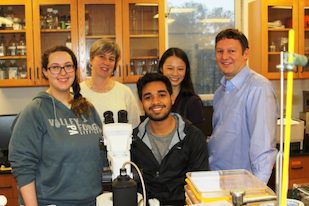Emory researchers have gained insights into how toxic Tau proteins kill brain cells in Alzheimer’s disease and other neurodegenerative diseases. Tau is the main ingredient of neurofibrillary tangles, one of two major hallmarks of Alzheimer’s.
Pathological forms of Tau appear to soak up and sequester a regulatory protein called LSD1, preventing it from performing its functions in the cell nucleus. In mice that overproduce a disease-causing form of Tau, giving them extra LSD1 slows down the process of brain cell death.
The results were published on November 2 in Proceedings of the National Academy of Sciences.
Blocking the interaction between pathological Tau and LSD1 could be a potential therapeutic strategy for Alzheimer’s and other diseases, says senior author David Katz, PhD, associate professor of cell biology at Emory University School of Medicine.
“Our data suggest that inhibition of LSD1 may be the critical mediator of neurodegeneration caused by pathological Tau,” Katz says. “Our intervention was sufficient to preserve cells at a late stage, when pathological Tau had already started to form.”
While the Katz lab’s research was performed in mice, they have indications that their work is applicable to human disease. They’ve already observed that LSD1 abnormally accumulates in neurofibrillary tangles in brain tissue samples from Alzheimer’s patients.

Engstrom, PhD
Mutations in the gene encoding Tau also cause other neurodegenerative diseases such as frontotemporal dementia and progressive supranuclear palsy. In these diseases, the Tau protein accumulates in the cytoplasm in an aggregated form, which is enzymatically modified in abnormal ways. The aggregates are even thought to travel from cell to cell.
Tau is normally present in the axons of neurons, while LSD1 goes to the nucleus. LSD1’s normal function is as an “epigenetic enforcer”, repressing genes that are supposed to stay off.
“Usually LSD1 and Tau proteins would pass each other, like ships in the night,” Katz says. “Tau only ends up in the cytoplasm of neurons when it is in its pathological form, and in that case the ships seem to collide.”
Former graduate student Amanda Engstrom PhD, the first author of the paper, made a short video that explains how she and her colleagues think LSD1 and Tau are coming into contact.






